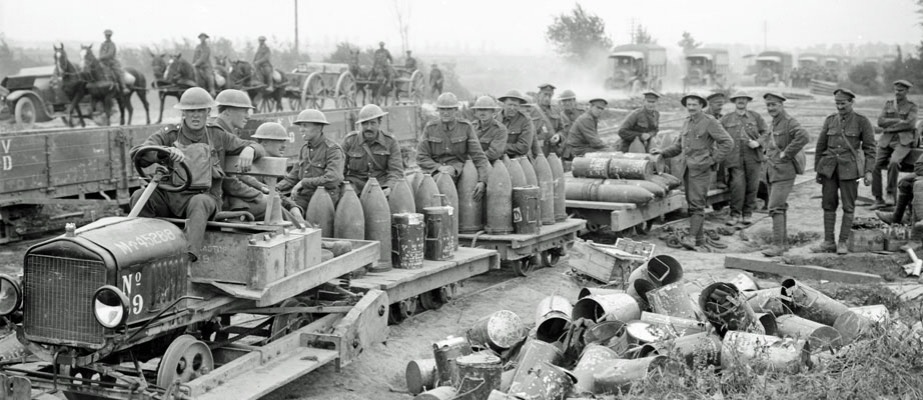Supply chains are an essential lifeline to soldiers in the field. Early in the Great War rapid advances, due to modern military equipment and strategy, meant that armies on both sides unwittingly outsripped their supply lines quickly. Prior to 1914 the prefered means of transporting equipment and provisions was via horse drawn carts. The devastation left behind by barrages of modern artillery resulted in huge swaths of land rendered impassable to traditional methods of supplying lines with necessary food and munitions. As the war waged on, progress slowed and eventually ground to a halt. Static, entrenched frontlines became the standard defensive tactic. Trenches were much easier to keep supplied than a marching army. At times, these defensive positions were so permanent that special small gauge rail systems were built, sometimes running through protective trenches of its own, linking outlying fronts to centralized supply hubs. Armoured cars briefly appeared, early in the war, as a means of transporting officers between the front lines and field operational bases, but were rendered obsolete relatively quickly due to a lack of mobility in the rapidly deteriorating backwoods of France. Most troop movement, on both sides, between military bases and the front lines was facilitated through a combination of rail travel and old-fashioned marching.

A lack of raw material and manufacturing capacity plagued both the Allied and Central Powers from early in the Great War. Well into 1915 the U.S. attempted to maintain neutrality in order to capitalize on wartime shortages on both sides. In efforts to hinder their enemy’s ability to sustain a protracted war, both the Allied and Central Powers employed subversive naval maneuvers. Through the duration of the Great War, the British Royal Navy maintained a blockade on shipments to Germany, Austria-Hungary, and the Ottoman Empire. The Germans, with a much smaller navy, could only affect a much smaller blockade in the German Bight, and instead turned to using unrestricted submarine warfare (using German U-boats as they were known to attack both military and civilian vessels) against the Allies. The effective British naval blockade on all imports into the Central Powers, coupled with the official U.S. declaration of war in 1917 meant that by the end of the Great War Germany and the other Central Powers were suffering from severe shortages of both food and raw materials. This deficiency in resources significantly contributed to the eventual outcome of the Great War.
By Micheal Williams
For further reading/Sources:
Bostrom, Alex. 2016. "Supplying the Front." French Historical Studies 39, no. 2: 261-286.
Creveld, Martin. Supplying War: Logistics from Wallenstein to Patton. Cambridge: U.K., Cambridge University Press. 2004
https://www.bl.uk/world-war-one/articles/supply-and-logistics
http://www.alu.army.mil/alog/issues/julaug09/over_there.html
http://www.iwm.org.uk/history/transport-and-supply-during-the-first-world-war